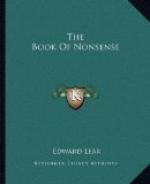“There was an Old Man
with a beard,
Who said, ’It is just
as I feared!
Two Owls and a Hen, four Larks
and a Wren,
Have all built their nests
in my beard!’”
With the kindly fatalism which is the distinctive note of the foregoing stanza, the sentiment of our next extract is in vivid contrast:—
“There was an Old Man
in a tree,
Who was terribly bored by
a bee;
When they said, ‘Does
it buzz?’ he replied, ’Yes, it does!
It’s a regular brute
of a Bee.’”
To the foregoing verse an historic interest attaches, if, that is, we are right in supposing it to have inspired Mr. Gilbert with his famous “Nonsense-Rhyme in Blank Verse.” We quote from memory:—
“There was an Old Man
of St. Bees,
Who was stung in the arm by
a wasp.
When they asked, ‘Does
it hurt?’ he replied, ’No, it doesn’t,
But I thought all the while
‘twas a Hornet!’”
Passing over the lines referring to the “Young Person” of Crete to whom the epithet “ombliferous” is applied, we may be pardoned—on the ground of the geographical proximity of the two countries named—for quoting together two stanzas which in reality are separated by a good many pages:—
“There was a Young Lady
of Norway,
Who casually sat in a doorway;
When the doors queezed her
flat, she exclaimed, ‘What of that?’
This courageous young person
of Norway.”
“There was a Young Lady
of Sweden,
Who went by the slow train
to Weedon;
When they cried, ‘Weedon
Station!’ she made no observation,
But thought she should go
back to Sweden.”
A noticeable feature about this first book, and one which we think is peculiar to it, is the harsh treatment which the eccentricities of the inhabitants of certain towns appear to have met with at the hands of their fellow-residents. No less than three people are “smashed,”—the Old Man of Whitehaven “who danced a quadrille with a Raven;” the Old Person of Buda; and the Old Man with a gong “who bumped at it all the day long,” though in the last-named case we admit that there was considerable provocation. Before quitting the first “Nonsense-Book,” we would point out that it contains one or two forms that are interesting; for instance, “scroobious,” which we take to be a Portmanteau word, and “spickle-speckled,” a favorite form of reduplication with Mr. Lear, and of which the best specimen occurs in his last book, “He tinkledy-binkledy-winkled the bell.” The second book, published in 1871, shows Mr. Lear in the maturity of sweet desipience, and will perhaps remain the favorite volume of the four to grown-up readers. The nonsense-songs are all good, and “The Story of the Four little Children who went Round the World” is the most exquisite piece of imaginative absurdity that the present writer is acquainted with. But before coming to that, let us quote a few lines from “The Jumblies,” who, as all the world knows, went to sea in a sieve:—




